Impact of Age, Weekly Working Hours, and Leisure time on Weekly Earnings – A Statistical Analysis Report
25 Pages4996 Words158 Views
Added on 2022-11-25
About This Document
This statistical analysis report examines the impact of age, weekly working hours, and leisure time on weekly earnings. It includes descriptive analysis, correlation and regression, and inferential statistics. The study focuses on the association between working and leisure time and analyzes the earnings based on available leisure time. The sample includes 40 employed and graduates individuals from the United States. The findings suggest that weekly earnings are dependent on educational degree. The study highlights the need for future research on the earning and work schedules of family members.
Impact of Age, Weekly Working Hours, and Leisure time on Weekly Earnings – A Statistical Analysis Report
Added on 2022-11-25
ShareRelated Documents
1
Impact of Age, Weekly Working Hours, and
Leisure time on Weekly Earnings – A Statistical
Analysis Report
Impact of Age, Weekly Working Hours, and
Leisure time on Weekly Earnings – A Statistical
Analysis Report
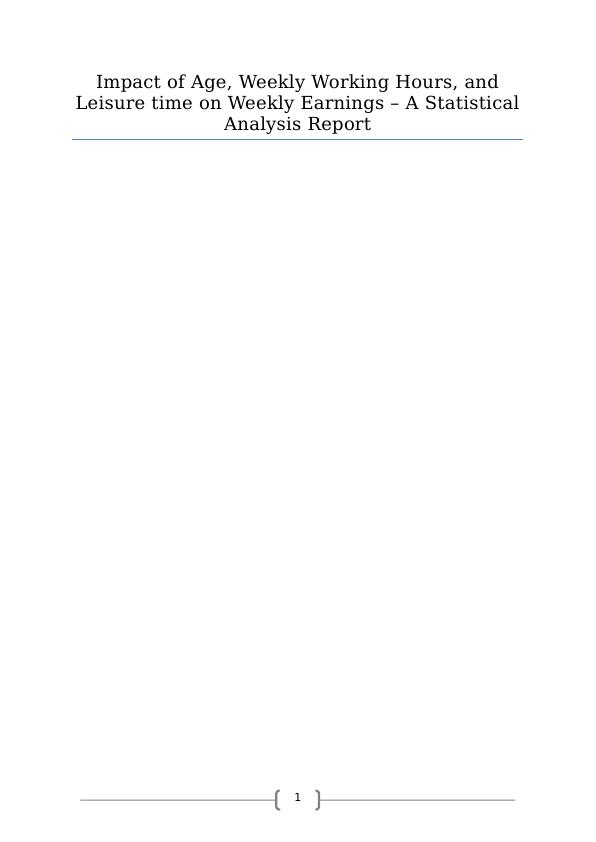
2
Table of Contents
Table of Tables............................................................................................2
Table of Figures...........................................................................................3
Introduction.................................................................................................3
Task 1: Descriptive Analysis........................................................................4
Outlier Removal and Data Cleaning.........................................................4
Descriptive Statistics................................................................................5
Age of Sample Observations.................................................................6
Weekly Earnings....................................................................................7
Weekly Working Hours........................................................................10
Leisure time per week.........................................................................11
Task 2: Correlation and Regression...........................................................13
Correlation Analysis................................................................................13
Regression Modelling.............................................................................16
Task 3: Inferential Statistics......................................................................17
Weekly Earnings by gender....................................................................17
Weekly Earnings by Educational Degree................................................18
Leisure per week by Gender...................................................................19
Leisure per week by Education Degree..................................................20
Conclusion.................................................................................................21
References................................................................................................22
Table of Contents
Table of Tables............................................................................................2
Table of Figures...........................................................................................3
Introduction.................................................................................................3
Task 1: Descriptive Analysis........................................................................4
Outlier Removal and Data Cleaning.........................................................4
Descriptive Statistics................................................................................5
Age of Sample Observations.................................................................6
Weekly Earnings....................................................................................7
Weekly Working Hours........................................................................10
Leisure time per week.........................................................................11
Task 2: Correlation and Regression...........................................................13
Correlation Analysis................................................................................13
Regression Modelling.............................................................................16
Task 3: Inferential Statistics......................................................................17
Weekly Earnings by gender....................................................................17
Weekly Earnings by Educational Degree................................................18
Leisure per week by Gender...................................................................19
Leisure per week by Education Degree..................................................20
Conclusion.................................................................................................21
References................................................................................................22
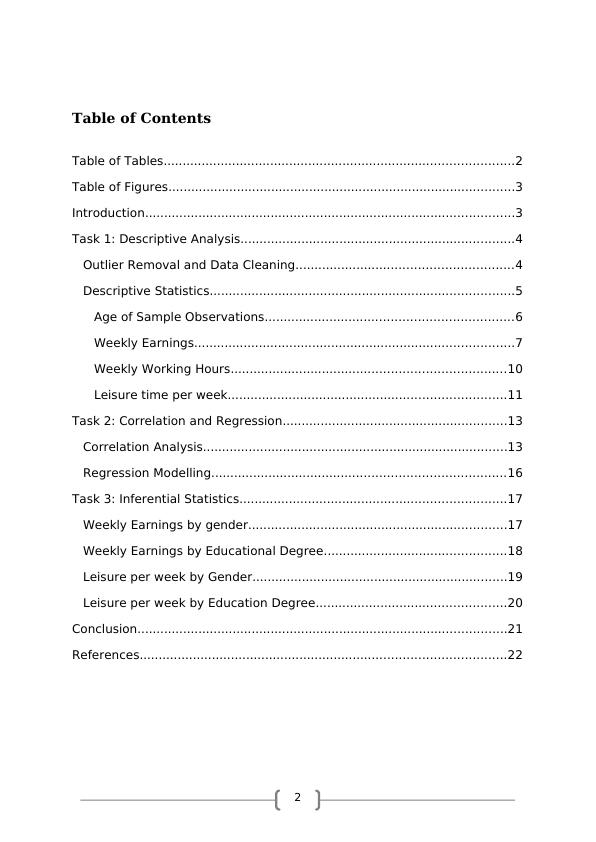
3
Table of Tables
Table 1: Descriptive Summary for N = 40 sample observations.................5Table 2: Descriptive Summary Comparison of Scale Variables concerning
Genders.......................................................................................................6Table 3: Correlation Matrix for the scale variables....................................13
Table 4: Multiple Regression Excel Output................................................16Table 5: Independent sample t-test for difference in weekly earnings by
gender.......................................................................................................17Table 6: One Way ANOVA for weekly earnings by education degree........18Table 7: Independent sample t-test for difference in weekly leisure time
spent by gender........................................................................................19Table 8: One Way ANOVA for weekly leisure time spent by education
degree.......................................................................................................20
Table of Figures
Figure 1: Side by side Box plots for Age of Individuals by Gender..............6Figure 2: Average Weekly Earnings for Male and Females..........................8Figure 3: Side-by-side Box plots for Weekly Leisure time by gender..........8Figure 4: Average Weekly Earnings by Education Degrees.........................9Figure 5: Side-by-side Box plots for Weekly Earning by Degree.................9
Figure 6: Average weekly earnings by age groups....................................10
Figure 7: Average Weekly Working Hours by genders and by education
degree.......................................................................................................10Figure 8: Side by side box plot for weekly work hours by gender.............11
Figure 9: Average leisure timing by gender..............................................11
Figure 10: Average leisure timing by education degree............................12
Figure 11: Side by side box plot for leisure time by gender......................12Figure 12: Scatterplot between Age and Weekly Earning.........................14
Table of Tables
Table 1: Descriptive Summary for N = 40 sample observations.................5Table 2: Descriptive Summary Comparison of Scale Variables concerning
Genders.......................................................................................................6Table 3: Correlation Matrix for the scale variables....................................13
Table 4: Multiple Regression Excel Output................................................16Table 5: Independent sample t-test for difference in weekly earnings by
gender.......................................................................................................17Table 6: One Way ANOVA for weekly earnings by education degree........18Table 7: Independent sample t-test for difference in weekly leisure time
spent by gender........................................................................................19Table 8: One Way ANOVA for weekly leisure time spent by education
degree.......................................................................................................20
Table of Figures
Figure 1: Side by side Box plots for Age of Individuals by Gender..............6Figure 2: Average Weekly Earnings for Male and Females..........................8Figure 3: Side-by-side Box plots for Weekly Leisure time by gender..........8Figure 4: Average Weekly Earnings by Education Degrees.........................9Figure 5: Side-by-side Box plots for Weekly Earning by Degree.................9
Figure 6: Average weekly earnings by age groups....................................10
Figure 7: Average Weekly Working Hours by genders and by education
degree.......................................................................................................10Figure 8: Side by side box plot for weekly work hours by gender.............11
Figure 9: Average leisure timing by gender..............................................11
Figure 10: Average leisure timing by education degree............................12
Figure 11: Side by side box plot for leisure time by gender......................12Figure 12: Scatterplot between Age and Weekly Earning.........................14
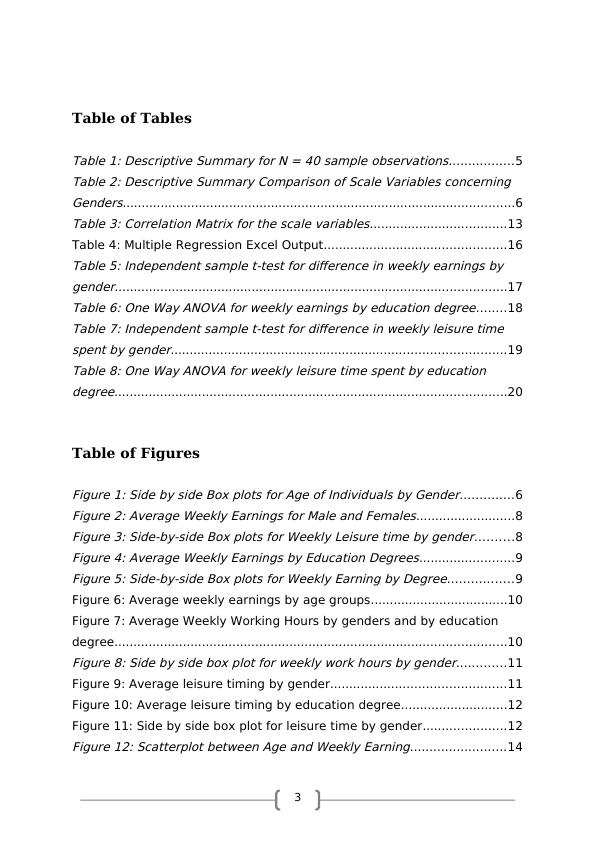
4
Figure 13: Scatterplot between Weekly working hours and Weekly Earning
..................................................................................................................14Figure 13: Scatterplot between Weekly leisure hours and Weekly Earning
..................................................................................................................15
Introduction
The debate on growth in employment and family conflicts is generally focused on the
ability of an individual’s prospect of earning, and the analysis of working time trends is
aimed at focusing on individual perception (Bianchi, & Milkie, 2010). The work-life balance
is increasingly highlighted in public debate and research with a rapidly evolving
multidisciplinary sector (Ernst Kossek, Lewis, & Hammer, 2010). As the upper boundary of
time limit for leisure is decided by time spent in the professional field, working hours are the
starting point for understanding the changing work and life balance in the United States
(Bianchi, & Milkie, 2010).
This study examines the debates regarding the association of working versus leisure
time, and then analyses the impact in earnings by focusing on the available leisure time
(sleeping, grooming, and housework).
The present study uses a sample of 40 employed and graduates individuals from the
population survey of 97275 individuals in the United States of America (American Time
Survey Results - 2018, 2019). Education degree, age range, employment status, gender, age,
weekly earnings, weekly hours worked, sleeping, grooming, and housework hours per week
were the selected variables. Education degree, age range, employment status, and gender are
the nominal/categorical variables. The scholar investigated the distribution of weekly
earnings and leisure time across gender, and education degrees of sample observations. The
inferential findings from independent t-test and one-way ANOVA suggest that weekly
earning of American people in the sample did not depend on an individual's gender (Barón, &
Cobb‐Clark, 2010). Interestingly, weekly earnings were found to be dependent on an
educational degree. Future studies need to focus more on the earning and work schedules of
family members compared to that of an individual’s work pattern.
Figure 13: Scatterplot between Weekly working hours and Weekly Earning
..................................................................................................................14Figure 13: Scatterplot between Weekly leisure hours and Weekly Earning
..................................................................................................................15
Introduction
The debate on growth in employment and family conflicts is generally focused on the
ability of an individual’s prospect of earning, and the analysis of working time trends is
aimed at focusing on individual perception (Bianchi, & Milkie, 2010). The work-life balance
is increasingly highlighted in public debate and research with a rapidly evolving
multidisciplinary sector (Ernst Kossek, Lewis, & Hammer, 2010). As the upper boundary of
time limit for leisure is decided by time spent in the professional field, working hours are the
starting point for understanding the changing work and life balance in the United States
(Bianchi, & Milkie, 2010).
This study examines the debates regarding the association of working versus leisure
time, and then analyses the impact in earnings by focusing on the available leisure time
(sleeping, grooming, and housework).
The present study uses a sample of 40 employed and graduates individuals from the
population survey of 97275 individuals in the United States of America (American Time
Survey Results - 2018, 2019). Education degree, age range, employment status, gender, age,
weekly earnings, weekly hours worked, sleeping, grooming, and housework hours per week
were the selected variables. Education degree, age range, employment status, and gender are
the nominal/categorical variables. The scholar investigated the distribution of weekly
earnings and leisure time across gender, and education degrees of sample observations. The
inferential findings from independent t-test and one-way ANOVA suggest that weekly
earning of American people in the sample did not depend on an individual's gender (Barón, &
Cobb‐Clark, 2010). Interestingly, weekly earnings were found to be dependent on an
educational degree. Future studies need to focus more on the earning and work schedules of
family members compared to that of an individual’s work pattern.

5
Task 1: Descriptive Analysis
Outlier Removal and Data Cleaning
The population data with survey response from 97275 individuals was scrutinized
thoroughly for selection of variables for the present study. Selection of variables was based
on the aim of the research. Timings for grooming, sleeping, and housework were converted to
per week data from per annum values. A new variable called leisure time per week was
constructed by summing per week timings of grooming, sleeping, and housework. The
analyses were conducted for earning, working, and leisure time spent in a week by an
American individual.
The selection of 40 samples from the population data set was based on the removal of outlier
observations and zero-valued observations for all the selected variables. The outlier values
were selected based on observations outside the range of [First quartile – 1.5 * Interquartile
Range and Third quartile – 1.5 * Interquartile Range] (Dawson, 2011). It was also noted that
no incomplete or missing values were included in the sample of 40 individuals. Removal of
outliers and missing observations were essential for the reliability of the small sample with a
size small as 40. It is to be noted that in the case of the very large sample with size greater
than 100, missing observations and outlier identification, instead of deletion would be
statistically preferable (Cousineau, & Chartier, 2010).
Descriptive Statistics
The average measurement of scale variables, age, weekly earnings, weekly working
hours, sleeping, grooming, and housework hours per week has been presented accompanied
by a graphical summary. Also, average measurements across the categorical variables have
Task 1: Descriptive Analysis
Outlier Removal and Data Cleaning
The population data with survey response from 97275 individuals was scrutinized
thoroughly for selection of variables for the present study. Selection of variables was based
on the aim of the research. Timings for grooming, sleeping, and housework were converted to
per week data from per annum values. A new variable called leisure time per week was
constructed by summing per week timings of grooming, sleeping, and housework. The
analyses were conducted for earning, working, and leisure time spent in a week by an
American individual.
The selection of 40 samples from the population data set was based on the removal of outlier
observations and zero-valued observations for all the selected variables. The outlier values
were selected based on observations outside the range of [First quartile – 1.5 * Interquartile
Range and Third quartile – 1.5 * Interquartile Range] (Dawson, 2011). It was also noted that
no incomplete or missing values were included in the sample of 40 individuals. Removal of
outliers and missing observations were essential for the reliability of the small sample with a
size small as 40. It is to be noted that in the case of the very large sample with size greater
than 100, missing observations and outlier identification, instead of deletion would be
statistically preferable (Cousineau, & Chartier, 2010).
Descriptive Statistics
The average measurement of scale variables, age, weekly earnings, weekly working
hours, sleeping, grooming, and housework hours per week has been presented accompanied
by a graphical summary. Also, average measurements across the categorical variables have
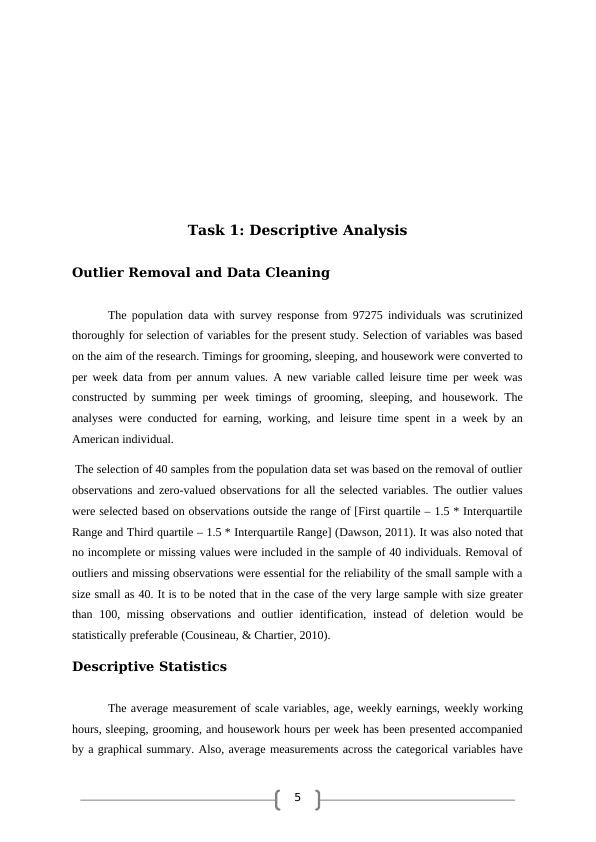
6
been created for a perfect understanding of the scale variables. Table 1 presents the
descriptive details of all the 40 individuals in the sample. The distribution of age and weekly
hours worked were slightly negatively skewed. Distributions of weekly earning, housework
time per week were slightly positively skewed. Again, sleeping hours and grooming hours
were noted to be almost normally distributed.
Table 1: Descriptive Summary for N = 40 sample observations
Age
Weekly
Earnings
Weekly
Hours
Worked
Sleeping
/week
Groomin
g/week
Housewor
k/week
Leisure/
Week
Mean 44.90 702.93 39.73 9.92 1.06 0.96 11.94
Median 45.00 621.00 39.50 10.13 1.15 0.96 11.73
Standard
deviation 11.07 324.74 5.97 1.95 0.46 0.64 2.06
Minimum 19.00 218.00 30.00 6.63 0.23 0.10 8.27
Maximum 64.00 1346.00 48.00 13.37 2.02 2.31 15.94
Range 45.00 1128.00 18.00 6.73 1.79 2.21 7.67
First
quartile 38.00 510.00 35.00 8.49 0.65 0.38 10.32
Third
quartile 54.00 926.75 45.00 11.30 1.30 1.18 13.53
Interquartile
range 16.00 416.75 10.00 2.81 0.65 0.79 3.22
Skewness -0.31 0.51 -0.20 0.06 0.20 0.54 0.22
Kurtosis -0.57 -0.64 -1.20 -0.99 -0.67 -0.67 -0.94
Age of Sample Observations
Table 2 contains the gender-wise descriptive summary of age, weekly earnings, per
week hours worked, sleeping, grooming, and housework hours per week. A comparative
study of averages reveals that the average age of 11 males was higher than that of 29 females.
The average age of males (M = 46.64 years, SD = 13.03 years) from Table 2 can be noted to
be greater than the overall average (M = 44.9 years, SD = 11.07 years) age of participants
(Table 1). The distribution of the age of males was highly negatively skewed, whereas,
distribution of age for females was almost normally distributed. The shape of the distributions
of age is pretty evident from the box plot in Figure 1 (Sopan et al., 2013).
been created for a perfect understanding of the scale variables. Table 1 presents the
descriptive details of all the 40 individuals in the sample. The distribution of age and weekly
hours worked were slightly negatively skewed. Distributions of weekly earning, housework
time per week were slightly positively skewed. Again, sleeping hours and grooming hours
were noted to be almost normally distributed.
Table 1: Descriptive Summary for N = 40 sample observations
Age
Weekly
Earnings
Weekly
Hours
Worked
Sleeping
/week
Groomin
g/week
Housewor
k/week
Leisure/
Week
Mean 44.90 702.93 39.73 9.92 1.06 0.96 11.94
Median 45.00 621.00 39.50 10.13 1.15 0.96 11.73
Standard
deviation 11.07 324.74 5.97 1.95 0.46 0.64 2.06
Minimum 19.00 218.00 30.00 6.63 0.23 0.10 8.27
Maximum 64.00 1346.00 48.00 13.37 2.02 2.31 15.94
Range 45.00 1128.00 18.00 6.73 1.79 2.21 7.67
First
quartile 38.00 510.00 35.00 8.49 0.65 0.38 10.32
Third
quartile 54.00 926.75 45.00 11.30 1.30 1.18 13.53
Interquartile
range 16.00 416.75 10.00 2.81 0.65 0.79 3.22
Skewness -0.31 0.51 -0.20 0.06 0.20 0.54 0.22
Kurtosis -0.57 -0.64 -1.20 -0.99 -0.67 -0.67 -0.94
Age of Sample Observations
Table 2 contains the gender-wise descriptive summary of age, weekly earnings, per
week hours worked, sleeping, grooming, and housework hours per week. A comparative
study of averages reveals that the average age of 11 males was higher than that of 29 females.
The average age of males (M = 46.64 years, SD = 13.03 years) from Table 2 can be noted to
be greater than the overall average (M = 44.9 years, SD = 11.07 years) age of participants
(Table 1). The distribution of the age of males was highly negatively skewed, whereas,
distribution of age for females was almost normally distributed. The shape of the distributions
of age is pretty evident from the box plot in Figure 1 (Sopan et al., 2013).
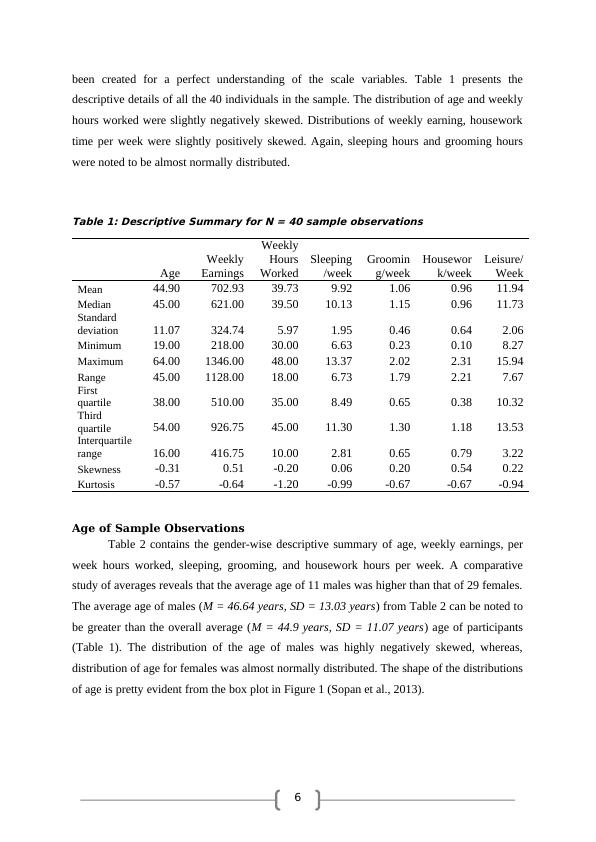
End of preview
Want to access all the pages? Upload your documents or become a member.
Related Documents
Further Analysis of Dataset for Cuteen Factorylg...
|14
|1373
|66
SPSS Statistics Assessment Quantitative Methods Assignmentlg...
|19
|3784
|116
